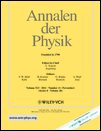Quantum mechanics needs no consciousness
Corresponding Author
S. Yu
Department of Neurophysiology, Max Planck Institute for Brain Research, Deutschordenstr. 46, 60528 Frankfurt am Main, Germany
Current address: Section on Critical Brain Dynamics, National Institute of Mental Health, 9000 Rockville Pike, Bethesda, MD 20892, USA
Department of Neurophysiology, Max Planck Institute for Brain Research, Deutschordenstr. 46, 60528 Frankfurt am Main, GermanySearch for more papers by this authorD. Nikolić
Department of Neurophysiology, Max Planck Institute for Brain Research, Deutschordenstr. 46, 60528 Frankfurt am Main, Germany
Frankfurt Institute for Advanced Studies, Johann Wolfgang Goethe University, Ruth-Moufang-Str. 1, 60438 Frankfurt am Main, Germany
Search for more papers by this authorCorresponding Author
S. Yu
Department of Neurophysiology, Max Planck Institute for Brain Research, Deutschordenstr. 46, 60528 Frankfurt am Main, Germany
Current address: Section on Critical Brain Dynamics, National Institute of Mental Health, 9000 Rockville Pike, Bethesda, MD 20892, USA
Department of Neurophysiology, Max Planck Institute for Brain Research, Deutschordenstr. 46, 60528 Frankfurt am Main, GermanySearch for more papers by this authorD. Nikolić
Department of Neurophysiology, Max Planck Institute for Brain Research, Deutschordenstr. 46, 60528 Frankfurt am Main, Germany
Frankfurt Institute for Advanced Studies, Johann Wolfgang Goethe University, Ruth-Moufang-Str. 1, 60438 Frankfurt am Main, Germany
Search for more papers by this authorAbstract
It has been suggested that consciousness plays an important role in quantum mechanics as it is necessary for the collapse of wave function during the measurement. Here we formulated several predictions that follow from this hypothetical relationship and that can be empirically tested. Experimental results that are already available suggest falsification of these predictions. Thus, the suggested link between human consciousness and collapse of wave function does not seem viable. We discuss the implications of these conclusions on the role of the human observer for quantum mechanics and on the role of quantum mechanics for the observer's consciousness.
References
- [1]D. Bohm, Phys. Rev. 85, 166–193 (1952).
- [2]E. Schrödinger, Phys. Rev. 28, 1049–1070 (1926).
- [3]J. von Neumann, Mathematical Foundations of Quantum Mechanics, Chap. VI, (1932) translated by R. T. Beyer (Princeton University Press, Princeton, 1955).
- [4]H. Primas and M. Esfeld, PhilSci Archive (1997), http://philsci-archive.pitt.edu/1574.
- [5]M. Esfeld, Stud. Hist. Philos. Sci. B 30, 145–154 (1999).
- [6]F.H. Thaheld, BioSystems 81, 113–124 (2005).
- [7]F. London and E. Bauer, La théorie de l'observation en mécanique quantique (1939), English translation in Quantum Theory and Measurement, edited by J. A. Wheeler and W. H. Zurek (Princeton University, Princeton, 1983) p. 217–259.
- [8]A. Shimony, Am. J. Phys. 31, 755–773 (1963).
- [9]J.G. Cramer, Rev. Mod. Phys. 58, 647–687 (1986).
- [10]D.J. Chalmers, The Conscious Mind: In Search of a Fundamental Theory, Chap. 10 (Oxford Univ. Press, New York, 1996).
- [11]L. Mandel, Rev. Mod. Phys. 71, S274–S282 (1999).
- [12]M.B. Menskii, Phys.-Usp. 43, 585–600 (2000).
- [13]C. Brukner and A. Zeilinger, Philos. Trans. R. Soc. Lond. A, Math. Phys. Eng. Sci. 360, 1061–1069 (2002).
- [14]S. French, Stud. Hist. Philos. Sci. B 33, 467–491 (2002).
- [15]C. Koch and K. Hepp, Nature 440, 611–611 (2006).
- [16]R. Penrose, The Road to Reality: A Complete Guide to the Laws of the Universe, Chap. 29 (Vintage Books, London, 2005).
- [17]B. Rosenblum and F. Kuttner, Quantum Enigma: Physics Encounters Consciousness, Chap. 16 (Oxford Univ. Press, New York, 2006).
- [18]M. Nauenberg, Found. Phys. 37, 1612–1627 (2007).
- [19]H.P. Stapp, Mindful Universe: Quantum Mechanics and the Participating Observer, Chap. 12 (Springer, Berlin, 2007).
- [20]A. Zeilinger, Rev. Mod. Phys. 71, S288–S297 (1999).
- [21]D. Kahneman, J. Beatty, and I. Pollack, Science 157, 218–219 (1967).
- [22]J. Silvanto, A. Cowey, N. Lavie, and V. Walsh, Nat. Neurosci. 8, 143–144 (2005).
- [23]K. Popper, Logik der Forschung (1935), English edition, Chap. 1 (Routledge, London and New York, 1992).
- [24]Y. Kim et al., Phys. Rev. Lett. 84, 1–5 (2000).
- [25]M.O. Scully and K. Drühl, Phys. Rev. A 25, 2208–2213 (1982).
- [26]N. Brunner, C. Branciard, and N. Gisin, Phys. Rev. A 78, 052110 (2008).
- [27]F.H. Thaheld, BioSystems 92, 114–116 (2008).
- [28]M. Caponigro, X. Jiang, R. Prakash, and R. Vimal, NeuroQuantology 8, 378–389 (2010).
- [29]J. Lachter, F. Durgin, and T. Washington, Vis. Cogn. 7, 269–279 (2000).
- [30]J.E. Raymond, K.L. Shapiro, and K.M. Arnell, J. Exp. Psychol. Hum. Percept. Perform. 18, 849–860 (1992).
- [31]R.A. Rensink, J.K. O'Regan, and J.J. Clark, Psychol. Sci. 8, 368–373 (1997).
- [32]A.M. Treisman and G. Gelade, Cogn. Psychol. 12, 97–136 (1980).
- [33]X.Y. Zou, L.J. Wang, and L. Mandel, Phys. Rev. Lett. 67, 318–321 (1991).
- [34]U. Eichmann et al., Phys. Rev. Lett. 70, 2359–2362 (1993).
- [35]S. Dürr, T. Nonn, and G. Rempe, Nature 395, 33–37 (1998).
- [36]M. Lockwood, Br. J. Philos. Sci. 47, 159–188 (1996).
- [37]M.B. Mensky, Opt. Spectrosc. 103, 461–467 (2007).
- [38]H. Atmanspacher, Quantum Approaches to Consciousness, in: The Stanford Encyclopedia of Philosophy, edited by E. N. Zalta (2011), http://plato.stanford.edu/entries/qt-consciousness.




